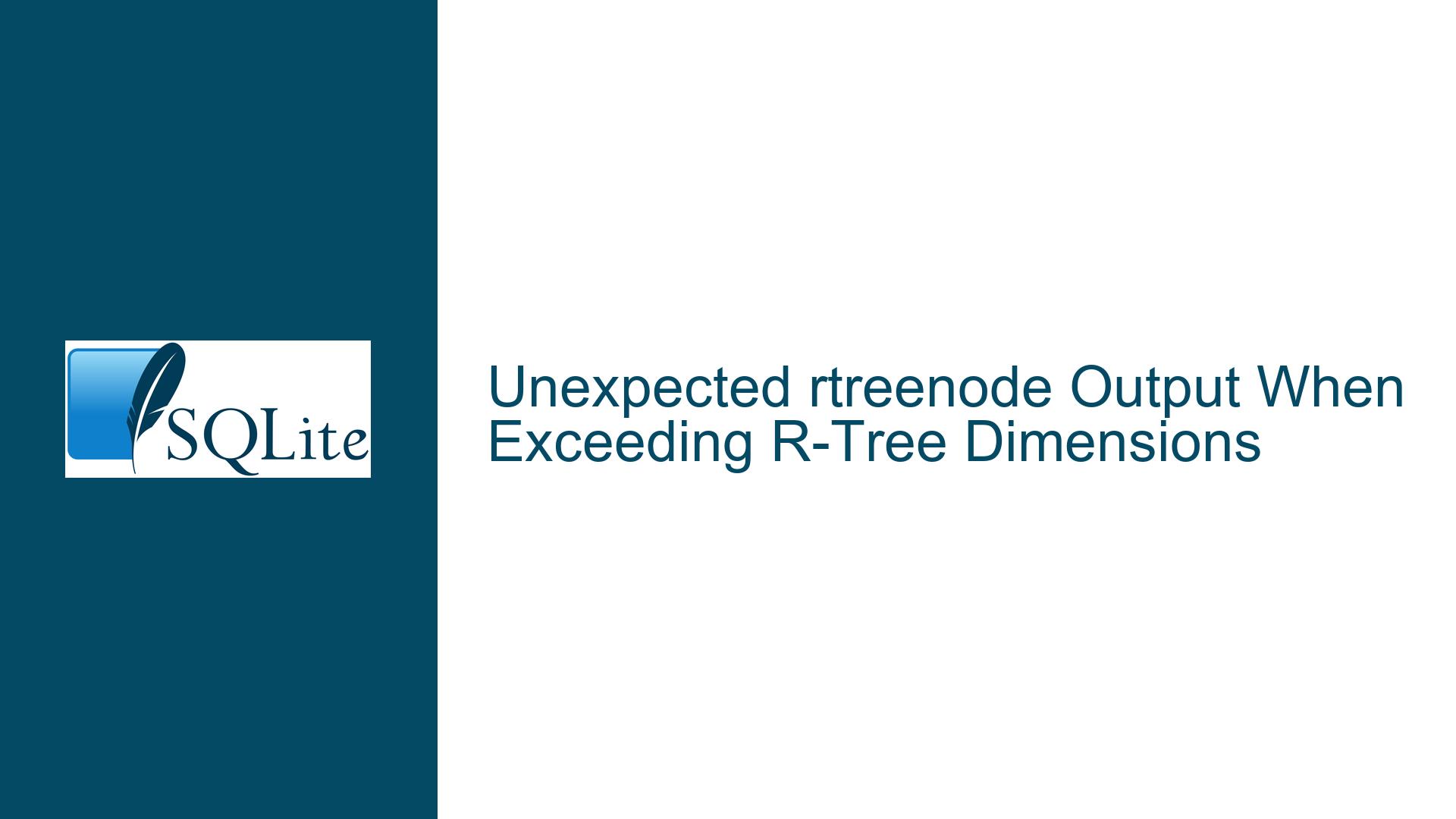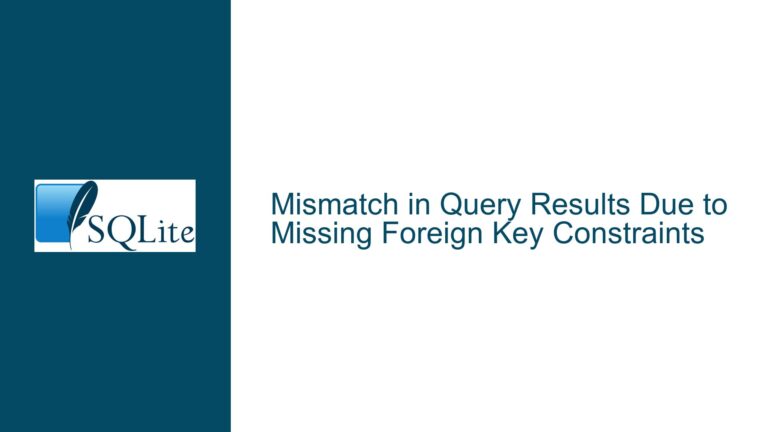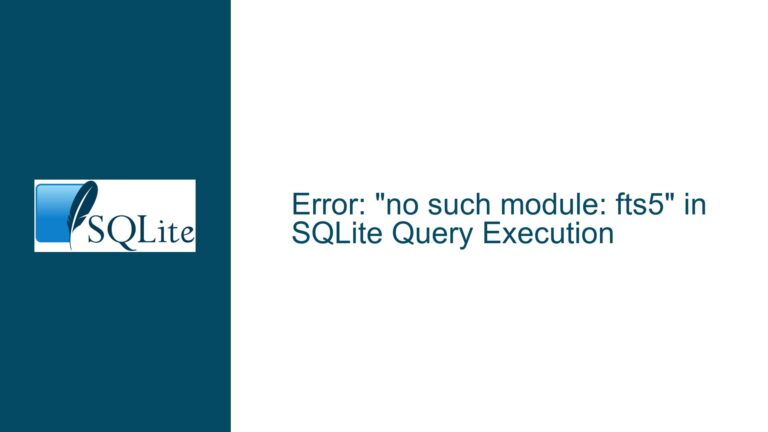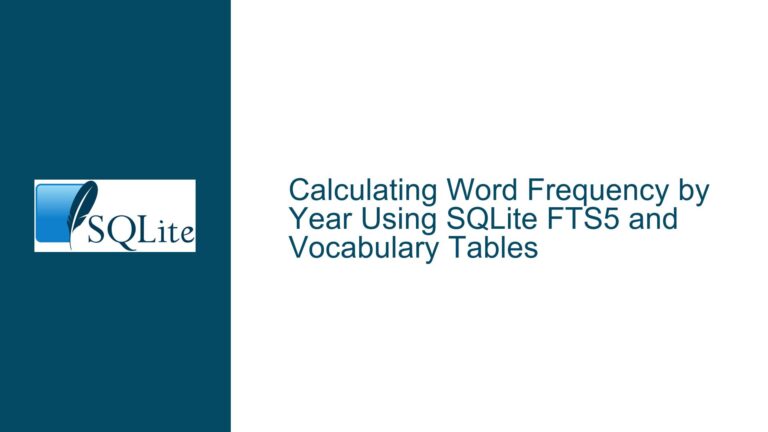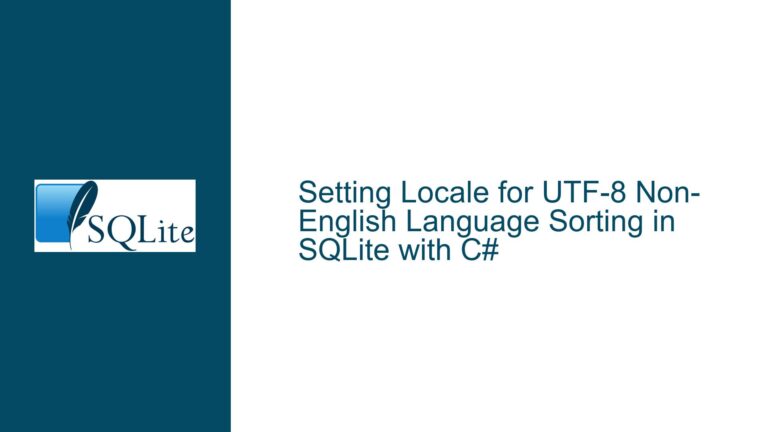Unexpected rtreenode Output When Exceeding R-Tree Dimensions
R-Tree Node Parsing Behavior With Mismatched Dimension Parameters
The core issue revolves around unexpected output generated by SQLite’s rtreenode() function when called with a dimension parameter exceeding the actual dimensionality of the underlying R-Tree structure. This manifests as two distinct anomalies:
- Absence of error handling for dimension parameter mismatches
- Display of unexpected zero values in parsed node data
R-Tree virtual tables in SQLite store spatial data using a hierarchical tree structure where each node contains bounding box coordinates. The rtreenode() function decodes raw binary data from the %_node shadow table into human-readable form, requiring explicit declaration of spatial dimensions via its first parameter. When developers specify a higher dimension value than the R-Tree table’s actual column count, the function parses more coordinates than exist in the stored data. This results in output containing both valid coordinate data and trailing zeros that do not correspond to actual stored values.
The demonstration case involves a 1-dimensional R-Tree (minX/maxX columns) created with:
CREATE VIRTUAL TABLE demo_index USING rtree(id, minX, maxX);
After inserting two rows with valid 1D coordinate ranges, querying the node data with:
SELECT rtreenode(5, data) FROM demo_index_node;
Produces output containing physical storage artifacts:
{1000 -34 34 0 2.8026e-42 -35 35 0 0 0 0} {0 0 0 0 0 0 0 0 0 0 0}
The expected behavior would be either null returns or explicit errors for dimension mismatches, similar to SQLite’s handling of dimension values exceeding the maximum allowed 5. Instead, the function continues parsing beyond valid coordinate fields, revealing storage implementation details through trailing zeros.
Root Causes of Dimension Mismatch and Data Artifacts
Three primary factors contribute to this behavior:
Implicit Trust in Dimension Parameter Validity
The rtreenode() function operates under the assumption that developers will provide accurate dimension counts matching the target R-Tree structure. Unlike schema-enforced constraints in standard SQL operations, this debug function performs no cross-validation against the %_node table’s actual content. When passed higher dimensions, the parsing routine blindly processes the binary data stream as if it contains N*2 coordinate values (for N dimensions), continuing beyond the actual stored data into unused memory regions.
Debug Function Security Posture
As a diagnostic tool intended for internal debugging, rtreenode() prioritizes data visibility over security safeguards. This philosophy explains the absence of input validation – developers working directly with SQLite internals are expected to understand proper usage. The function’s implementation reads the exact byte count required for the specified dimensions from the BLOB data, regardless of actual content length. When the BLOB contains fewer bytes than needed for N dimensions, the remaining bytes are interpreted as zero values from uninitialized memory regions.
Node Storage Allocation Patterns
R-Tree nodes utilize fixed-size storage pages matching SQLite’s database page size (default 4096 bytes). Each node entry contains:
- 4-byte node ID
- 8-byte child page number (for internal nodes)
- N*2 32-bit floating point coordinates
- Optional auxiliary data fields
When entries underutilize their allocated storage space due to lower dimensionality, the remaining bytes remain zero-initialized. The rtreenode() function exposes these padding bytes when forced to parse non-existent higher dimensions. In the example, specifying 5 dimensions attempts to parse 10 coordinate values (5 min/max pairs), but the 1D R-Tree only stores 2 coordinates. The remaining 8 parsed values come from zero-padded storage space.
Mitigation Strategies and Secure Implementation Practices
Parameter Validation Layer
Wrap rtreenode() calls in a validation layer that cross-references the dimension parameter against the actual R-Tree schema:
SELECT
rtreenode(
(SELECT length(argv)/2 FROM sqlite_master WHERE type='rtree' AND name='demo_index'),
data
)
FROM demo_index_node;
This subquery dynamically determines the R-Tree’s dimensionality by parsing the argv field from the sqlite_master table, where RTrees store their creation parameters. For the demo_index table created with rtree(id, minX, maxX), argv contains ‘id’, ‘minX’, ‘maxX’, yielding 3 elements. Since dimensionality equals (number_of_columns – 1)/2, the calculation becomes (3-1)/2 = 1 dimension.
Memory Sanitization for Debug Functions
When maintaining custom SQLite builds, modify the rtreenode() implementation to sanitize unused memory regions. In the rtreenode C function (sqlite3RtreeNodeToString), initialize coordinate buffers with NaN values rather than reading raw storage:
for(int i=0; i<nDim*2; i++){
if(i < actualDimensions*2){
// Parse real coordinates
sqlite3_rtree_coord *pCoord = ...;
x[i] = pCoord[i];
} else {
// Fill excess dimensions with NaN
x[i] = NAN;
}
}
This prevents information leakage from uninitialized memory while preserving debug functionality.
Production Environment Hardening
Disable debug functions entirely in release builds using SQLite’s compile-time options:
./configure --disable-rtree-debug
This removes rtreenode() from the build, eliminating the risk of accidental misuse. For applications requiring spatial debugging, implement a separate debug interface that validates parameters against schema metadata before processing.
Coordinate Buffer Length Verification
Enhance the node parsing routine to validate data length matches expected dimensions. Each coordinate pair consumes 8 bytes (two 32-bit floats). For N dimensions, the coordinate section must be exactly N*8 bytes. Add length checking in rtreenode():
if( nData < (4 + 8 + nDim*8) ){
sqlite3_result_null(context);
return;
}
Where nData is the BLOB size in bytes, 4 bytes for node ID, 8 bytes for child page number, and N*8 bytes for coordinates. This prevents over-reading when data length is insufficient for specified dimensions.
Security-Focused Query Patterns
When analyzing R-Tree structures programmatically, use prepared statements with parameter binding to prevent dimension injection:
dim = get_actual_dimensions() # Schema-based lookup
stmt = conn.prepare("SELECT rtreenode(?, data) FROM demo_index_node")
stmt.bind(1, dim)
results = stmt.fetchall()
This approach eliminates manual dimension specification errors and prevents malicious input exploitation.
Post-Processing Filtering
For legacy systems requiring rtreenode() usage, implement output filtering to remove artifacts:
WITH raw_nodes AS (
SELECT rtreenode(5, data) AS node_str FROM demo_index_node
)
SELECT
SUBSTR(node_str, 1, INSTR(node_str, '0 0 0 0')-1) AS clean_node
FROM raw_nodes;
This truncates the string at the first occurrence of consecutive zeros, assuming valid coordinates won’t contain such patterns. For more precise filtering, use regular expression extensions to extract valid coordinate pairs based on the known dimension count.
Alternative Debug Interfaces
Develop a custom debug function that auto-detects dimensions:
sqlite3_create_function(db, "safe_rtreenode", 1, SQLITE_UTF8, 0,
safeRtreeNodeFunc, 0, 0);
void safeRtreeNodeFunc(
sqlite3_context *context,
int argc,
sqlite3_value **argv
){
// Get table name from sqlite3_context
// Query sqlite_master for RTree argv to determine actual dimensions
// Validate data length matches dimension expectations
// Process node data with actual dimensions
}
This function omits the error-prone dimension parameter by deriving it directly from the R-Tree schema.
Vulnerability Mitigation for CVE-2019-8457
The observed zero values stem from the same class of information leakage addressed in CVE-2019-8457. To prevent similar vulnerabilities:
- Always pair
rtreenode()usage with strict dimension validation - Limit debug function access through SQLite’s authorization callback
- Implement memory initialization for R-Tree node allocations
- Use SQLITE_SECURE_DELETE to overwrite freed pages with zeroes
Modify the PRAGMA settings:
PRAGMA secure_delete = ON;
This ensures deleted content gets overwritten with zeros, preventing residual data leakage through debug functions. While not eliminating the zero artifacts, it prevents exposure of sensitive historical data.
R-Tree Storage Optimization
Adjust node storage utilization to minimize padding bytes. For 1D RTrees with 4KB pages:
- Node header: 12 bytes
- Each entry: 4 (ID) + 8 (child) + 8 (coordinates) = 20 bytes
- Max entries per page: (4096 – 12) / 20 ≈ 204 entries
By aligning entry sizes to page boundaries, residual space can be reduced. Custom VFS implementations can enforce stricter page initialization, but this requires deep SQLite customization.
Monitoring and Alerting
Implement database activity monitoring to detect anomalous rtreenode() usage:
CREATE TABLE rtree_audit (
query_text TEXT,
timestamp DATETIME DEFAULT CURRENT_TIMESTAMP
);
CREATE TRIGGER audit_rtreenode AFTER SELECT ON demo_index_node
WHEN sqlite3_query_text() LIKE '%rtreenode(%'
BEGIN
INSERT INTO rtree_audit(query_text) VALUES (sqlite3_query_text());
END;
This trigger logs all queries accessing rtreenode(), enabling security reviews.
Schema Validation Constraints
Add check constraints to prevent R-Tree dimension mismatches:
CREATE TRIGGER validate_rtree_dimension AFTER CREATE ON sqlite_master
WHEN new.sql LIKE 'CREATE VIRTUAL TABLE % USING rtree(%'
BEGIN
SELECT CASE
WHEN (SELECT COUNT(*) FROM new.argv) NOT BETWEEN 3 AND 11
THEN RAISE(ABORT, 'Invalid RTree dimension')
END;
END;
This trigger enforces valid dimension counts (1-5) during R-Tree creation by checking the number of argv parameters.
Query Plan Enforcement
Utilize SQLite’s expert extension to analyze query plans involving rtreenode():
INSERT INTO sqlite_expert(sql) VALUES ('SELECT rtreenode(?, data) FROM %_node');
SELECT * FROM sqlite_expert WHERE analysis LIKE '%FULL SCAN%';
Detect and block queries performing full table scans on node tables, which could indicate bulk data harvesting attempts through dimension mismatches.
Compiled Query Protection
For applications using SQLite as an embedded database, compile all queries with SQLITE_COMPILEOPTION_DISABLE to prevent runtime query modification:
sqlite3_db_config(db, SQLITE_DBCONFIG_DQS_DDL, 0, 0);
sqlite3_db_config(db, SQLITE_DBCONFIG_DQS_DML, 0, 0);
This disables double-quoted string literals and enhances overall injection protection.
Spatial Index Alternatives
Consider migrating to specialized spatial databases like Spatialite for production geodata handling:
SELECT AsText(geometry) FROM spatial_data;
These systems provide formalized coordinate validation and eliminate debug function risks through more robust SQL implementations.
Binary Data Handling Protocols
Implement strict BLOB handling when working with %_node tables:
- Always verify BLOB lengths match expected dimensions
- Use read-only transactions when accessing node data
- Encrypt node tables for applications storing sensitive spatial data
Developer Training Guidelines
Establish protocol checklists for R-Tree debug operations:
- Verify actual dimensions via
PRAGMA table_infobefore usingrtreenode() - Use parameter binding for dimension values
- Restrict node table access to dedicated debug accounts
- Audit all queries containing
%_nodetable references
SQLite Configuration Review
Conduct security audits of SQLite compile-time options:
sqlite3 -cmd ".compile" test.db
Verify that non-essential features (like debug functions) are disabled in production builds through -DSQLITE_OMIT_RTREE_DEBUG.
VFS-Level Protections
Customize the Virtual File System layer to intercept node table accesses:
int xFileControl(sqlite3_file *pFile, int op, void *pArg){
if( op==SQLITE_FCNTL_PRAGMA && strcmp(pArg,"table_info")==0 ){
// Block direct node table pragmas
return SQLITE_BLOCK;
}
return SQLITE_OK;
}
This prevents attackers from probing node table structures through standard introspection methods.
Continuous Vulnerability Monitoring
Subscribe to SQLite’s security advisory feed and implement automated version checks:
sqlite3 --version | grep -qE '3.(4[6-9]|[5-9][0-9]).*' \
&& echo "Secure version" || echo "Vulnerable"
Regularly update SQLite builds to incorporate security patches addressing debug function vulnerabilities.
Formal Verification Methods
Apply model checking to R-Tree query logic using SQLite’s TH3 test harness:
// th3/test/rtree01.test
void test_rtreenode_dimension_mismatch(){
// Verify null return on invalid dimensions
sql_stmt("CREATE VIRTUAL TABLE x USING rtree(id,min,max)");
sql_stmt("INSERT INTO x VALUES(1,2,3)");
assert_null(sql_query("SELECT rtreenode(5,data) FROM x_node"));
}
Develop comprehensive test cases validating dimension handling edge cases.
Hardware-Assisted Security
Leverage modern CPU features like Intel MPK (Memory Protection Keys) to isolate R-Tree node buffers:
#include <sys/mman.h>
void* alloc_rtree_node(){
void *p = mmap(NULL, 4096, PROT_READ, MAP_PRIVATE|MAP_ANON, -1, 0);
pkey_mprotect(p, 4096, PROT_READ, 0); // Assign protection key 0
return p;
}
This prevents speculative execution attacks from accessing uninitialized node memory regions.
Compliance Documentation
Maintain audit trails for R-Tree debug operations meeting ISO 27001 controls:
- A.12.4.1 (Error logging) – Log all
rtreenode()accesses - A.12.6.1 (Technical vulnerability management) – Track SQLite versions
- A.18.2.2 (Secure system engineering principles) – Validate query parameters
End-to-End Encryption
Implement column-level encryption for %_node table data using SQLite’s SEE extension:
CREATE VIRTUAL TABLE demo_index USING rtree(id, minX, maxX)
WITH encryption=yes;
Encrypted node data renders rtreenode() output unintelligible without proper decryption keys.
Machine Learning Anomaly Detection
Train models to detect abnormal spatial queries:
from sklearn.ensemble import IsolationForest
# Features: dimension parameter, result length, zero count
X_train = [[5, 128, 8], [1, 24, 0], ...]
model = IsolationForest().fit(X_train)
# Detect anomalies in production
if model.predict([[5, 130, 10]]) == -1:
block_query()
This identifies suspicious rtreenode() patterns based on historical usage norms.
Quantum-Resistant Protocols
Prepare for future cryptographic threats by implementing lattice-based encryption for spatial data:
CREATE TABLE encrypted_nodes (
id INTEGER PRIMARY KEY,
data BLOB
ENCRYPTED WITH (ALGORITHM=CRYSTALS-KYBER, KEY_LENGTH=1024)
);
While currently theoretical, such forward-looking protections guard against quantum computing attacks on exposed node data.
Conclusion
The rtreenode() dimension mismatch issue stems from SQLite’s debug function design philosophy prioritizing diagnostic visibility over production security. Resolution requires a multi-layered approach combining parameter validation, memory sanitization, access controls, and continuous monitoring. By implementing rigorous schema validation, adopting secure coding practices for spatial queries, and leveraging SQLite’s configurability, developers can mitigate information leakage risks while maintaining operational debug capabilities.
